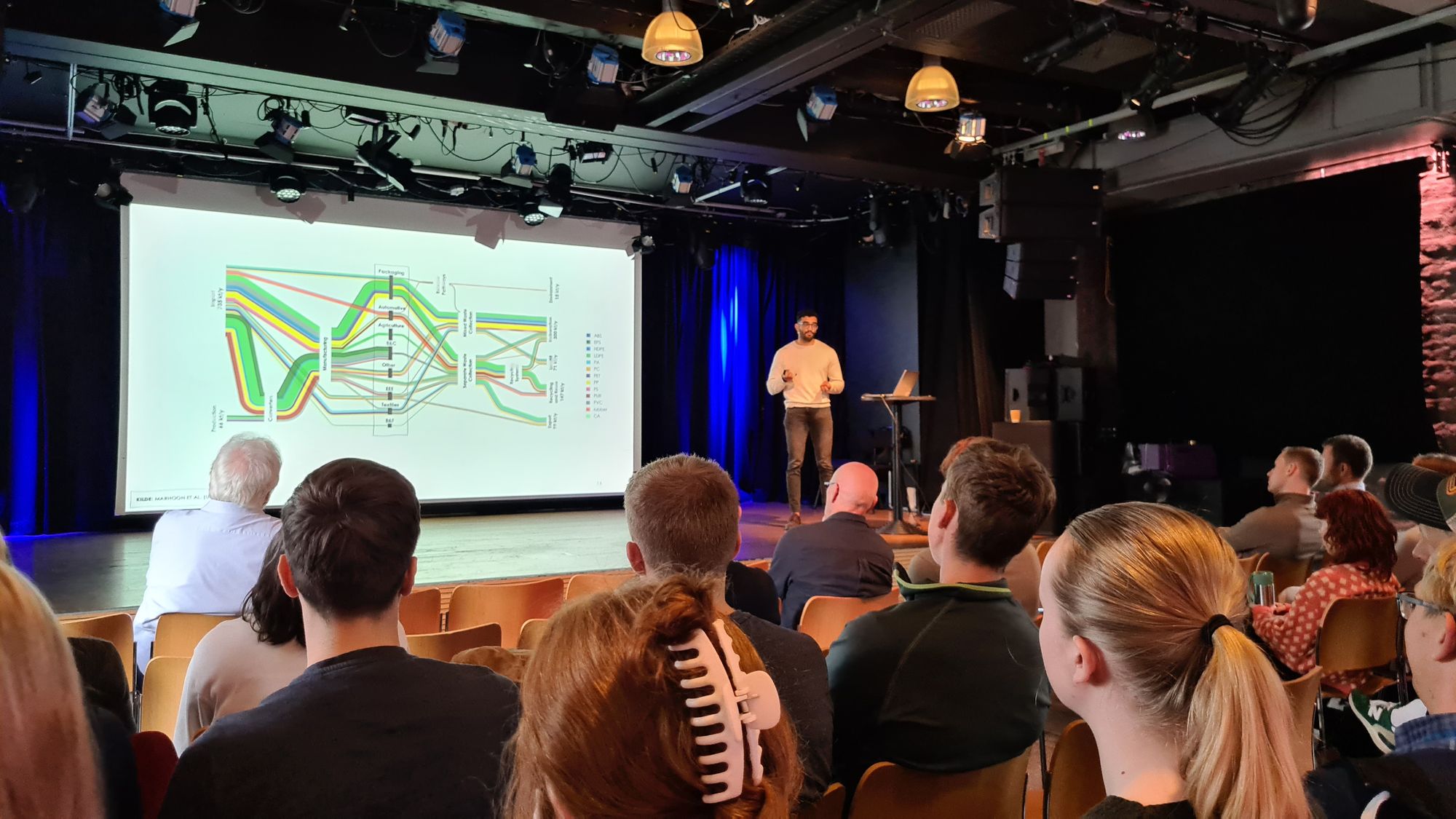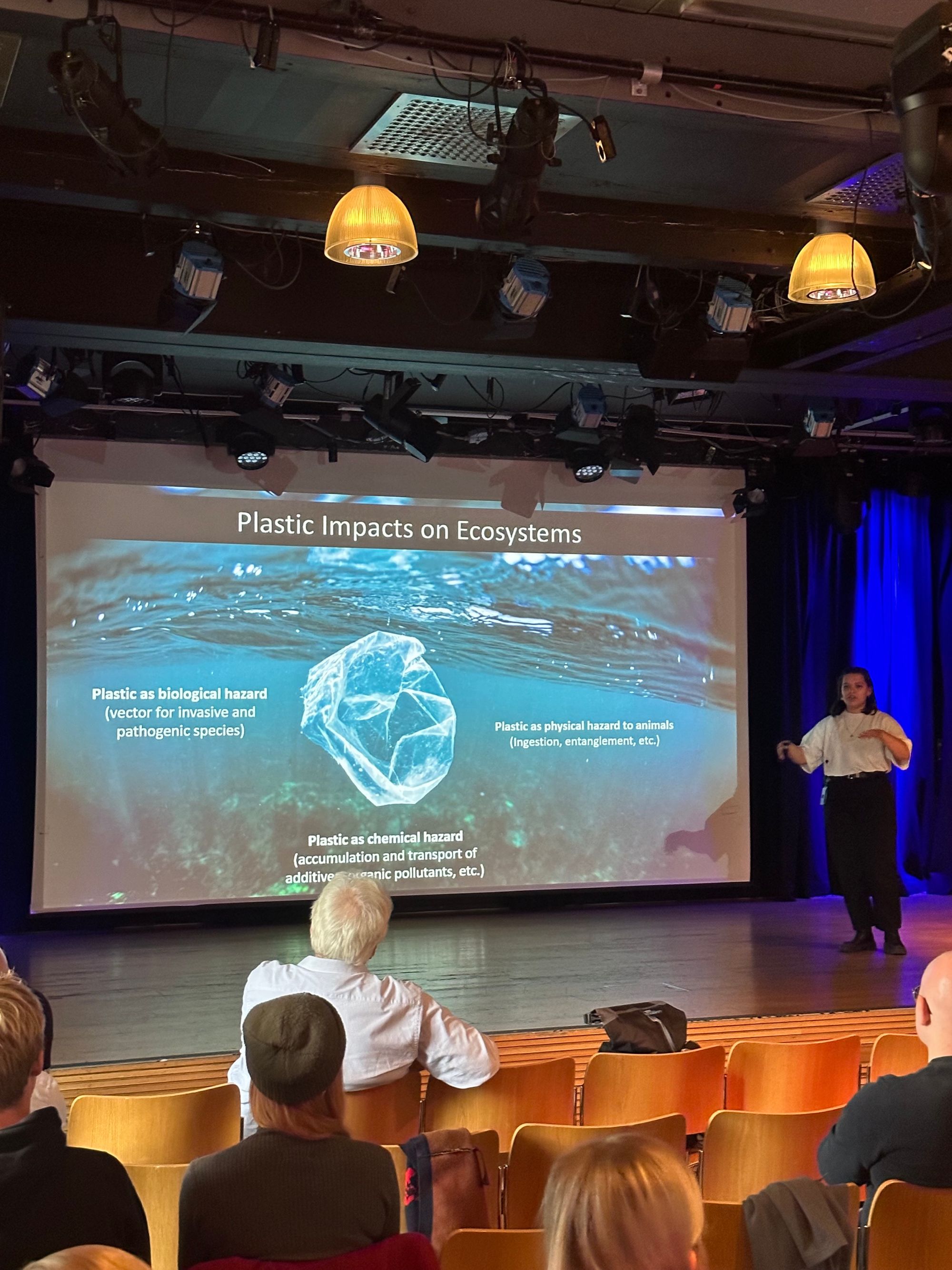"Plastic day" / "Plastdagen" in Trondheim
Guest author: Gabrielle Häberli
Time: 12th of October 2023
Location: Dokkhuset, Trondheim.
Plastics – incredibly useful
Plastic is an umbrella term describing a wide range of materials often perceived as "non-natural". They date back more than 100 years although their production only really "took flight" as an industry in 1907 when Leo Baekeland created Bakelite. Plastics have had a significant influence on human development and today it's nearly impossible to avoid contact with plastic in our day-to-day life; it's everywhere around us. Some technologies started only after plastics were invented but are today no longer in need of plastics, like celluloid used in photographic film. Other sectors have experienced massive developments after the invention of plastics, as we see in: The healthcare industry, due to plastic's ability to isolate and so keep hygiene; rubber car tires, for friction and so safety; plastic bottles and other storage equipment, which immensely improved shipping; and the use of plastic as a light and durable material generally improved many inventions from hiking equipment to airplanes.
But not unlike nuclear power, this great invention comes with a responsibility. If plastics are not properly - we'd dare say perfectly - managed then they have immense environmental impacts. Plastics that are lost to the environment are practically impossible to retrieve and, in addition, many plastic products are estimated to take 500 years to decompose. In light of this, both industry and science have a responsibility to the sustainability of the plastic industry, and a small piece of a very large effort was witnessed at "Plastdagen".

The 2023 edition of Plastdagen took place on the 12th of October, uniting in Dokkhuset (Trondheim) people from industry, academic and scientific research, to open the discussion around sustainable solutions to tackle plastic pollution. Karl Klingsheim, the organizer of the event, catered a mix of lectures, posters exhibition and one-on-one discussions, all motivated by a common goal: contribute to a greener future. The issue was addressed through a diverse range of relevant angles. Multiple companies and organizations contributed, bringing insight into UN treaties, waste management, project funding, etc.
NTNU research also had its share of the spotlight, represented by PhD students from the ATLANTS and MAPLE projects.
In the perspective of ATLANTIS and MAPLE
As many of our most vigilant readers by now probably know, ATLANTIS is a taskforce determined to introduce marine biodiversity impacts in the framework of Life Cycle Impact Assessments (LCIA, see the book on "Life Cycle Impact Assessment" by Hauschild and Huijbregts, 2015). Philip from ATLANTIS presented how both macro- and microplastic pollution affects marine biodiversity and through this also global climate change when emitted to end up in the final environmental "sink" of plastics: The ocean.

The impacts in focus from macroplastics were: Entanglement, ingestion, invasive species spread, and damage to tourism and culture. Especially marine mammals birds have been observed to entangle themselves in plastics which leads to laceration, strangling, and so death. Animals of all sizes, birds and zooplankton, have been witnessed to ingest plastics which has both toxic effects and also slows feeding of actual nutrients leading to sickness and starvation. And invasive species, especially barnacles and mollusks, have been seen "hitchhiking" on floating plastic debris and thereby reach pristine environments where they bring havoc and imbalance heavily impacting the welfare of the native species communities in recipient ecosystems. And then plastics are ugly to look at which diverts tourists from coastal societies whose economy is reliant on tourism, especially now that pollution and over-exploitations of different kinds have eradicated their marine source for food.
The impacts from microplastics mainly deal with the growth inhibition of phytoplankton which sends cascading effects through the marine trophic web, especially primary producers. Among other things, phytoplankton aggregates in lumps to micro-plastic particles which for any individual not on top of the aggregate decreases the amount of sunlight needed for photosynthesis. In addition, such lumps may sink to deeper waters rendering the same effect. Since primary production is the greatest natural "engine" for carbon sequestration, the inhibition of these species has an indirect, but significant, impact on climate change.
ATLANTIS is therefore developing impact assessment methods for the above mentioned issues to use in LCIA. In midst of the excitement and appreciation of the many different perspectives and ideas to combat plastic pollution, we also noticed the use of life cycle assessments (LCA, the framework including LCIAs) on plastic products which underlines the importance of our work. For the evaluation of product and policy environmental assessments and also environmental product declarations (EPDs), LCA becomes an increasingly more important and popular tool. But for plastic products, some of the most devastating impacts are not yet considered in the modelling framework and so decisions are made without the inclusion of these factors. We warned people at Plastdagen that while LCA is improving and expanding fast to include such impacts, we are not yet there. We encourage the use of LCAs, but we must remember what each model is able to assess and not forget to also qualitatively assess what our models cannot yet do. When asked when the ATLANTIS models are ready for use, we answered honestly: We cannot say how long it will take for these models to mature into a state where they are robust enough to be used for industrial and political decision-making - but we already know the answer to solve this plastic crisis without the models. Stop the excessive and unnecessary use of plastic wherever possible even if a product system becomes economically more costly.

This is something that Ahmed emphasized when he presented his work at Plastdagen. He developed a Material Flow Analysis (MFA) model that quantifies the plastic flows in the Norwegian economy and further estimates the amounts that leak to the environment. He showed that the Norwegian waste management is already highly efficient, and further cuts in plastic leakages entails a consumption reduction of certain products, such as consumer packaging and agricultural products. He also highlighted tire wear rubber as the major source of microplastic pollution, and current policies and regulations overlook this source. Ahmed also presented an estimation of the plastic additives that get released alongside plastic products. Many of the substances he included are toxic, understudied or poorly regulated, which shows the other dimension of the plastic crisis. His work was submitted for revision in a peer-reviewed journal, and we hope to see it published in the very near future. Ahmed’s PhD is part of MAPLE (Marine Plastic Pollution: Environmental Impact and life cycle scenarios) project, funded by NTNU’s interdisciplinary sustainable initiative, where his role is to assess the sustainability performance and develop scenarios for a more sustainable Norwegian plastic economy.

Alongside Ahmed in the MAPLE project, Gabrielle Häberli, a PhD student in the biology department at NTNU, works on the relationship between marine plastic debris and microorganisms. She presented her work on the impact of plastic on marine microbial communities and impact of microbial communities on plastic fate. This dual point of view is necessary to assess risks on biodiversity, as well as development of strategies for regulation and mitigation. Elucidating the complex plastic-microbe interactions is key to modelling impact and fate scenarios. Gabrielle aims to provide a better understanding of microbial colonization dynamics on marine plastic debris and potential plastic biodegradation in Trondheimsfjord, by using a mix of molecular and microscopy techniques. Hopefully adding to the scarce understanding of what we call the plastisphere (or plastic microbiome). In addition, Gabrielle provided important distinction in the terms used to describe plastic biodegradation. As microbes have an apparent role in ocean plastic mitigation, and overall fate, the distinction of terms such as “degradation” and “mineralization” are needed to give the public the correct understanding of microbe-plastic dynamics, and potential biotechnological solutions for the future.
ATLANTIS and MAPLE projects are examples of current efforts aiming to fill the research gaps in the plastic pollution crisis. We hope more opportunities, like Plastdagen, will allow us to reach and sensibilize a wider public with regard to this critical issue.


